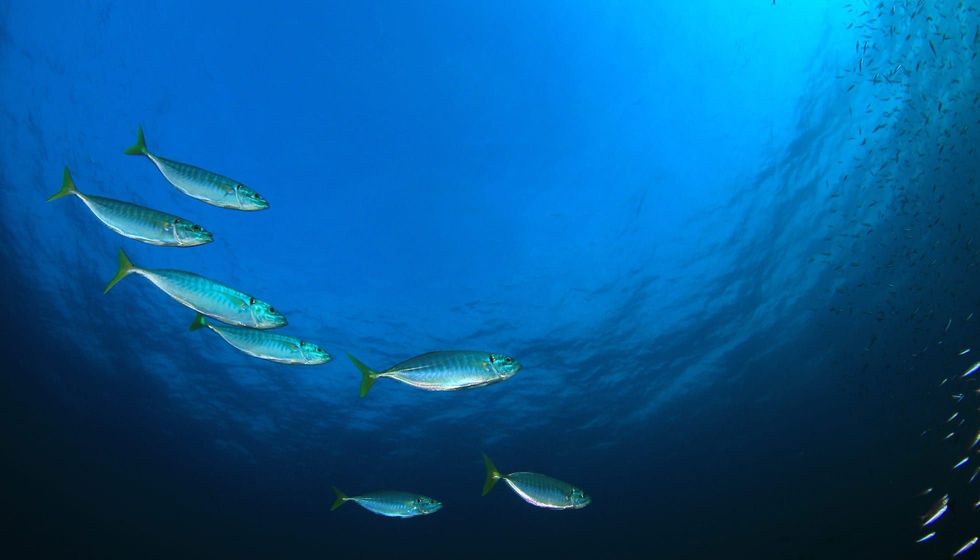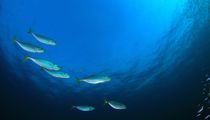The Pacific bonito (Sarda chiliensis lineoata), also known as skipjack tuna, is a medium-sized member of the Scombridae or Mackerel Family. Another form of identification of these fish is also the names the eastern Pacific bonito and the southern Pacific bonito.
There are two subspecies of the Pacific bonito, the Sarda chiliensis lineolata from the northern populations which are found in southern Baja California in Mexico and southern California. Also, the Sarda chilensis chiliensis from the southern populations are found in the subtropical eastern Pacific, Peru to Talcahuano, Mancora, and Chile.
However, during warm-water conditions, these fish are also found in Vancouver Island and Washington.
These bonitos are a major part of the fishing industry in California and Baja California in Mexico.
For more relatable content, check out these monkfish facts and rockfish facts for kids.
Pacific Bonito Interesting Facts
What type of animal is a Pacific bonito?
The Pacific bonito (Sarda lineolata), also known as skipjack tuna, is a bonito species, a spindle-shaped game fish but not thought of as a good food fish. Earlier these fishes were believed to be a subspecies of Sarda chiliensis.
What class of animal does a Pacific bonito belong to?
These fish belong to the class of Actinopterygii and they are ray-finned fish. Actinopterygians comprise almost 30,000 species of fishes including piranhas and other species. There are four species in the Sarda genus which include mackerels, skipjack, and tunas including yellowfin tunas.
How many Pacific bonitos are there in the world?
These bonitos are managed in commercial fisheries and recreational fishing because the population was declining due to excessive fishing. After proper management, the populations of this fish are now on the rise without overfishing.
Where does a Pacific bonito live?
Pacific bonito range along southern California coast and Baja California in Mexico during the spring season and throughout the winter. Sarda orientalis, another species of bonito, is present in the Sea of Cortez which looks similar to its related species.
These fishes are generally found near warm coastal inshore waters and range from British Columbia Vancouver Island to the waters of Sur, Baja California.
What is a Pacific bonito's habitat?
Pacific bonito fish, also known as skipjack tuna, are pelagic, meaning they live in open water.
This fish can be found within a range of 20 mi (32 km) near the shore. This species often travels outside kelp beds, juvenile Pacific bonito enter bays, and from time to time they are found in the line of foam formed by waves breaking on a reef or seashore.
These fish mostly spend their time within 50 ft (15.2 m) of the surface and are known for hanging out as deep as 360 ft (110 m).
Bonitos migrate during the summer season up to 621 mi (1,000 km) to a cooler water habitat to escape the warm waters which replicates the migration of their prey too.
Who do Pacific bonitos live with?
Pacific bonitos are a species of pelagic schooling fish and are normally found in large schools and even hunt in schools. An individual bonito lures its prey by clamping them outside the water while feeding on them.
How long does a Pacific bonito live?
The maximum lifespan of a Pacific bonito is eight to 12 years if it is not caught by a fishing boat.
How do they reproduce?
Pacific bonito fish or skipjack tuna reproduce by the age of two, and as they grow up to 2 ft (61 cm) long, they lay up to 500,000 eggs over a spawning season. The spawning season for a Pacific bonito starts from spring to summer. The ability to produce an abundance of offspring increases significantly as they grow.
What is their conservation status?
The Pacific bonito is listed as a species of Least Concern on the IUCN Red List, however over the past 10 years, their population has decreased drastically.
In the past, these pelagic fishes were an integral part of commercial fisheries which eventually led to a decrease in their population. As a result of this population decline, the rate of fishing of this species has thankfully dropped and they are no longer targeted as much.
They were also caught while schooling in a large wall of netting deployed around schools of fish annually at a staggering number of up to 4,600,000 fish, weighing up to 34,000,000 lb (15,422,140 kg).
Pacific Bonito Fun Facts
What do Pacific bonitos look like?
The Pacific bonito (Sarda chiliensis) is a tuna that has an elongated round spindle-shaped body that is designed aerodynamically for speed. These fish are silvery with a greenish dark blue back and dark head, their belly and flanks are silvery, with a concatenation of five to six stripes crosswise along their upper area.
The pelvic and anal fins are white in color, their caudal fin and the pectoral fin are gray and subdivided with two-minute bases. They have a fairly large mouth with large protruding teeth.
The anal fin has six to seven finlets and 12-15 rays. The first dorsal fin has 17-19 rays and the second dorsal fin has 12-15 rays.
This species has 15-18-gill rakers on the lower body and eight gill rakers on the upper body and the front body part are covered with large scales. The first dorsal fin is adjoining with the second dorsal fin and is longer than the head.

* Please note that this is an image of a tuna, not a Pacific bonito. If you have an image of a Pacific bonito please let us know at hello@kidadl.com.
How cute are they?
Pacific bonito fish are not considered cute. However, their spindle-shaped silvery greenish-blue color and slanted stripes on their backs make them look elegant.
How do they communicate?
Similar to other species of fish, Pacific bonito fish have otoliths consisting of a sensory epithelium which is made up of calcareous otoliths and their hair cells.
How big is a Pacific bonito?
They are powerful and blistering swimmers. Females live longer than males and grow to a larger size than males. The average size of a mature Pacific bonito is 40 in (101.6 cm) length. This makes it a tad bit bigger than the Spanish mackerel.
How fast can a Pacific bonito swim?
Pacific bonito are blistering and agile swimmers and can swim up to 40 mph (64.3 kph) and can travel up to 20 mi (32.1 km) when they swim.
How much does a Pacific bonito weigh?
Pacific bonito fish can grow up to 4-20 lb (1.8-9 kg) in weight. Juvenile Pacific bonito fish flourish rapidly but then start to grow slowly as they reach the age of five years. The sizes of a Pacific bonito can vary at sexual maturity based on area and sex. Female Pacific bonito are heavier than males.
What are the male and female names of the species?
Different names for males and females of this species are not given. The identification of either gender is difficult to differentiate by their appearance.
What would you call a baby Pacific bonito?
Unfortunately, a baby Pacific bonito has not been given a specific name and is known as a baby or a small bonito.
What do they eat?
Pacific bonito fish, a species of tuna, mainly feed on northern anchovies, sardines, euphausiids, crustaceans, amphipods, and squid. Squid is a major part of their diet. Pacific bonito fish are seen forcing schools of small fish to clump together, pushing the waters while feeding on them. Their teeth are conical and small in shape.
Are they dangerous?
Pacific bonito fishes can be dangerous as they are predatory fishes. This species is carnivorous in nature and are a threat to other fish species in the water.
Would they make a good pet?
Humans do not domesticate the Pacific bonito. They are not ideal pets as they need big open oceans and plenty of food. As these species are good game fish, anglers use different types of live bait on a hook to catch them.
Did you know...
Pacific bonito (Sarda chiliensis) fish are dried, seethed, and smoked to produce bonito flakes, a well-known Japanese cuisine called Katsuobushi.
Pacific bonito fish is a fast-growing skipjack tuna and it is low in mercury contamination.
Pacific bonito fish feed on squid and are pelagic fish.
They are caught on a variety of lures and bait. The best bait for this game fish is small sardines or live anchovies, fished with a cast-a-bubble or on a sliding leader.
Anglers used to use the best lures for catching this fish by using bonito feather lures which are affixed to either a golf ball, a cast-a-bubble, or a wooden float, which causes disturbance on the surface of the water, attracting the bonito fish and keeps the lures near the surface.
The largest Pacific bonito ever caught was over 30 in (75 cm) in length and the weight was 18.2 lb (8.3 kg).
Bonito fish are often caught by purse seine fishing nets, a method that uses a fishing net, hung vertically with the bottom edge held down by weights and by using floats on the top to keep it afloat.
Pacific bonito are also caught using a live lure or bait on a hook and line, trawling, gill nets, casting, surface trolling, and jigging near sea or ocean shore.
What is unique about the Pacific bonito?
The Pacific Bonito is the only tuna-like fish to have a number of dark, slanted stripes along its back in California.
Like the salmon, the South Pacific bonito fish is a good food fish and is considered mild in flavor, a dense texture with moderate fat, and large flakes.
For good results, these fish should be cleaned as soon as it is captured as the flesh can be quite tasty if it is bled immediately after being caught and then put on ice.
However, if it warms up in a sack typically made of jute fiber on a pier, the flesh can become inedible.
Some regions of the flesh are darker in color and are more strongly flavored.
Most people remove these dark parts of the flesh unless they desire the fish for smoking. Due to the high oil content, the best cooking method is to broil the meat and the worst method is deep-frying the fish as this increases the oil level.
How did the Pacific bonito get its name?
The bonito got their name from the Spanish word 'bonito' which translates to 'pretty'. Another theory is that the name is actually derived from the Arabic word 'bainīth', which too is derived from the Spanish language.
Here at Kidadl, we have carefully created lots of interesting family-friendly animal facts for everyone to discover! Learn more about some other fish from our green sunfish facts and koi facts pages.
You can even occupy yourself at home by coloring in one of our free printable pacific bonito coloring pages.
* Please note that the main image is of a mackerel, the parent of a Pacific bonito. If you have an image of a Pacific bonito please let us know at hello@kidadl.com.









